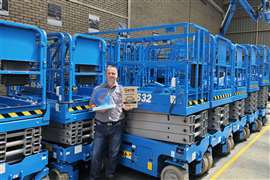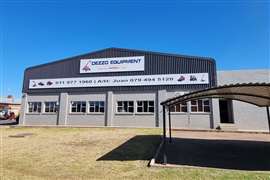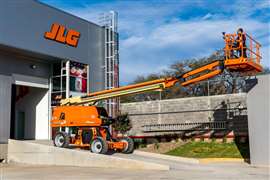New Venice bridge
28 February 2008
Venice is one of the world's most famous cities. The historic Italian city, on a small island in the Adriatic Sea, just off the mainland, is characterised by its many waterways that form the heart of the city's infrastructure. Both roadways and cars are limited. The one and only major 'road' through the city is the Grand Canal. It is a busy waterway that meanders through the ancient old city with its many famous buildings and sights.
Until recently the Grand Canal was spanned by only three bridges of which the Rialto Bridge, completed in 1591, is the oldest and most famous. Its stone structure is regarded as an architectural marvel. Now, more than 400 years later, the fourth bridge is of the hands of a famous architect from our age, Spanish-born Santiago Calatrava. He designed a sleek and slender arch bridge, constructed from steel, stone and glass. Not without controversy the City decided on Calatrava's design in 1999. The new bridge will be located almost at the end of the Grand Canal, connecting the railway station to the main bus station at the Piazzale Roma.
The construction contract for the bridge, including the preparations on land, was awarded to Cignoni. The actual construction and pre-assembly was done between 2004 and 2007 and included several delays. Cignoni awarded the contract for the complicated transport and installation of the three section bridge to Italian heavy transport and lifting specialist Fagioli Group.
The bridge actually took shape over time at Fumagalli's yard, part of the Fagioli Group, in Porto Marghera, on the mainland just opposite Venice. Over night the oversized and pre-assembled bridge sections were carried to the yard by road. Cranes were used to assist in assembling the bridge to its final dimensions and shape. Cignoni further completed the bridge. The arch-type steel structure is 85.30 m long and 9.05 m wide. For transport and installation purposes the structure is split into one centre section and two buttress sections, measuring, respectively, 55.20 x 9.05 x 3.70 m and 15.10 x 7.90 x 1.50 m each. The largest section weighs 250 tonnes while the smaller each weigh 85 tonnes.
Transport and final installation of the bridge started in July 2007. Just like the bridge, the project was split into two separate operations. First, both buttresses were handled in one operation, to be followed by the centre section in another just a week later.
Barge job
The 85 tonne buttress sections were loaded on to modular trailers using an 800 tonne capacity Demag AC 800 telescopic mobile crane, owned by Calabrese, and on rent to Fagioli for the entire operation. Both sections were carried to a roll-on/roll-off berth in the nearby port. One section travelled on a conventional modular trailer while the other was moved on an eight line Cometto SPMT. At the berth Susanna, a barge measuring 50 x 16 x 3.50 m, together with the push boat Mantova, were already awaiting all equipment to be loaded. As the installation of the buttresses would require the AC 800 again, the crane was driven on board and set up on outriggers. One buttress section was transferred from the trailer on to the barge where it was temporarily positioned on beams within reach of the crane. The other section, carried on the SPMT, was driven on board and parked at the other end of the barge.
Navigating the Grand Canal with the pusher and barge measuring more than 75 m long and 16 m wide was at the limits of its possibilities. This required, just like a transport by road, permits to be arranged, temporary parking restrictions to be applied at critical locations along the Grand Canal, escort vessels and police boats to be arranged.
To minimise disturbance to regular traffic on the Grand Canal, navigating the convoy would only be allowed during the night. In a delicate operation taking more than four hours the pusher and barge, assisted by four other support vessels, sailed through the canal. Crossing the three bridges required careful navigation, especially when crossing the Rialto Bridge. At this point the limited headroom underneath the bridge coincided with a restricted left turn straight after the bridge. This, however, was only the rehearsal for the central span still to come. The immense convoy, squeezing itself through the illuminated city with its beautiful old buildings, squares and small canals, was almost unrealistic and more like a scene from a movie.
During the following two days both buttresses were put in place on either bank of the canal. The 800 tonne Demag was rigged with full ballast. First, it lifted the section lying in front of the crane, slewed it through 180 degrees and lowered it on to its concrete foot. During slewing, the listing of the barge was carefully monitored while ballasting was performed to keep it level during all stages of the operation. The other section on the opposite bank required a slightly different approach, requiring the SPMT to drive the section within reach of the crane while also keeping the barge level.
On the move
A week after the successful completion of the first stage, the second, and even more complicated, operation was imminent involving the centre section of the bridge. In this case loading on to transport was performed by an almost integrated heavy lift system that would also be used for the final positioning of the bridge section over the Grand Canal.
Fagioli used a set of four 600 tonne capacity EZ Lifter 600-33 hydraulic gantries, a product of Riggers Manufacturing Co. in the US. Two gantries were positioned at either side and in the middle of the bridge section. They were standing 13.31 m apart, centre to centre, interconnected by a purpose built steel frame.
On top of the frame two special adaptors were installed to fit the tubular design of the bridge's spine. The centre bridge section, weighing 250 tonnes, was lowered on to a double wide 10-line Cometto SPMT. Two cross beams on the SPMT formed the support for the longitudinal beams fitted to the gantries.
By fully retracting the hydraulic gantries they could remain in place during transport. In this case the computer controlled multi-directional steering of the SPMTs already proved its worth when manoeuvring the 55 m long and 9 m wide load from the yard on to public roads towards the roll-on/roll-off berth in the port. In this case loading was also performed by means of roll-on on to the same barge and push boat.
Just like the buttresses, the centre section would also be moved across Venice and along the Grand Canal during the night. The red painted bridge would be permanently illuminated during transport. In this case the operation was even more complicated due to the slightly increased overall length in combination with the increased height. Crossing the Rialto Bridge would prove if all extensive preparations, simulations and measurements were correct.
Floating precision
With even more people lined up along both banks of the Canal, and even standing on the Rialto Bridge, the new Calatrava bridge safely passed underneath the old arch with only some 800 to 900 millimeters to spare at both sides. Reaching the final installation site late that night, the barge was temporarily moored in the S. Chiara Canal.
The next step involved the delicate operation of turning the 55 m long section through 90 degrees while pivoting around its centre point, using one of the computer controlled steering modes of the Cometto SPMTs. Also, during this operation, stability of the barge was continuously monitored. Once the centre section was standing square to the barge, the delicate operation of moving towards and in between both buttresses was next. But first steel load spreading mats were positioned underneath the four hydraulic gantries by a forklift on board the barge. Slowly the gantries lifted the centre bridge section clear from the buttresses. Assisted by push boat Mantova, a work ship at the other end and a winch on each corner of the barge the section was manoeuvred into place and finally lowered in to position.
After completion of the installation of the steel framed bridge by Fagioli, it is now up to Cignoni to complete the bridge on site for it to open at the end of the year.






